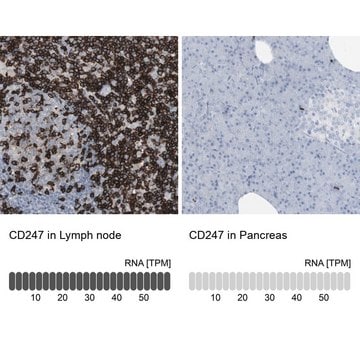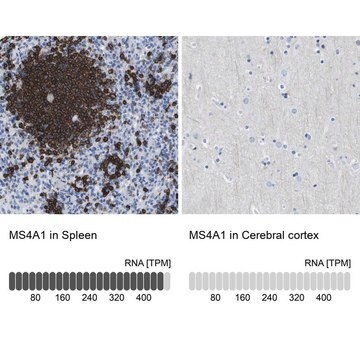ZRB2344
Anti-CD3ζ/CD247 Antibody, clone 1N11 ZooMAb® Rabbit Monoclonal

recombinant, expressed in HEK 293 cells
Sinônimo(s):
CD247, T-cell receptor T3 zeta chain, T-cell surface glycoprotein CD3 zeta chain
About This Item
Produtos recomendados
fonte biológica
rabbit
Nível de qualidade
recombinante
expressed in HEK 293 cells
conjugado
unconjugated
forma do anticorpo
purified antibody
tipo de produto de anticorpo
primary antibodies
clone
1N11, recombinant monoclonal
descrição
1N11 Clone
linha de produto
ZooMAb® learn more
forma
lyophilized
peso molecular
calculated mol wt 18.7 kDa
observed mol wt ~16 kDa
purificado por
using Protein A
reatividade de espécies
human
embalagem
antibody small pack of 25 μL
características do produto alternativo mais ecológico
Waste Prevention
Designing Safer Chemicals
Design for Energy Efficiency
Learn more about the Principles of Green Chemistry.
validação aprimorada
recombinant expression
Learn more about Antibody Enhanced Validation
técnica(s)
affinity binding assay: suitable
flow cytometry: suitable
immunocytochemistry: suitable
immunohistochemistry: suitable
western blot: suitable
Isotipo
IgG
sequência de epítopo
C-terminal half
nº de adesão de ID de proteína
nº de adesão UniProt
categoria alternativa mais ecológica
Condições de expedição
ambient
temperatura de armazenamento
2-8°C
Informações sobre genes
human ... CD247(919)
Descrição geral
Especificidade
Imunogênio
Aplicação
Evaluated by Western Blotting in Jurkat cell lysate.
Western Blotting Analysis: A 1:10,000 dilution of this antibody detected CD3 /CD247 in Jurkat cell lysate.
Tested Applications
Western Blotting Analysis: A 1:10,000 dilution from a representative lot detected CD3 /CD247 in Human spleen tissue lysate.
Immunocytochemistry Analysis: A 1:100 dilution from a representative lot detected CD3 /CD247 in Jurkat cells.
Immunohistochemistry (Paraffin) Analysis: A 1:1,000 dilution from a representative lot detected CD3 /CD247 in human tonsil tissue sections.
Affinity Binding Assay: A representative lot of this antibody bound CD3 with a KD of 5.0 x 10-7 in an affinity binding assay.
Flow Cytometry Analysis: 0.1 µg from a representative lot detected CD3 /CD247 in one million Jurkat cells.
Note: Actual optimal working dilutions must be determined by end user as specimens, and experimental conditions may vary with the end user.
Descrição-alvo
forma física
Reconstituição
Armazenamento e estabilidade
Outras notas
Informações legais
Exoneração de responsabilidade
Not finding the right product?
Try our Ferramenta de seleção de produtos.
Código de classe de armazenamento
11 - Combustible Solids
Classe de risco de água (WGK)
WGK 1
Ponto de fulgor (°F)
Not applicable
Ponto de fulgor (°C)
Not applicable
Certificados de análise (COA)
Busque Certificados de análise (COA) digitando o Número do Lote do produto. Os números de lote e remessa podem ser encontrados no rótulo de um produto após a palavra “Lot” ou “Batch”.
Já possui este produto?
Encontre a documentação dos produtos que você adquiriu recentemente na biblioteca de documentos.
Nossa equipe de cientistas tem experiência em todas as áreas de pesquisa, incluindo Life Sciences, ciência de materiais, síntese química, cromatografia, química analítica e muitas outras.
Entre em contato com a assistência técnica





